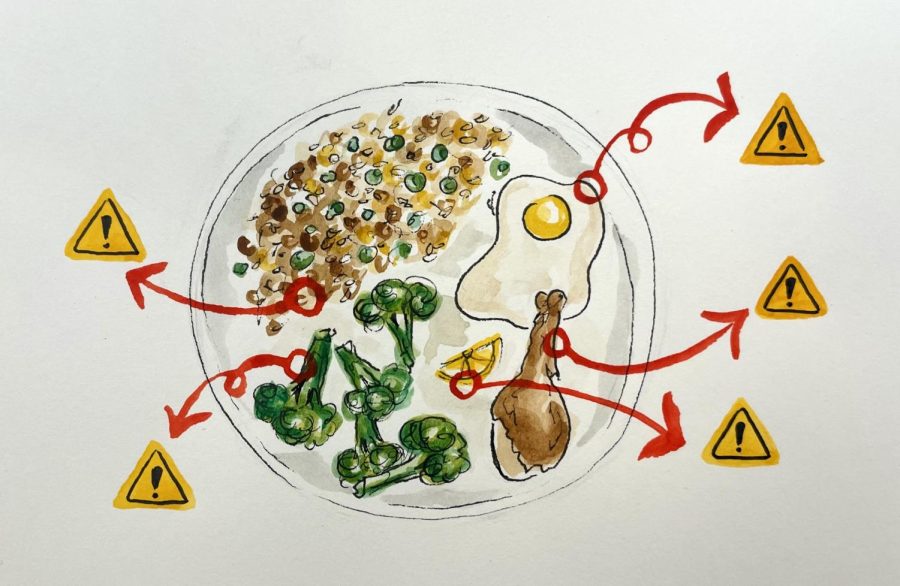UVM Dining needs updated cross-contamination policies
Eating in UVM’s dining halls is virtually impossible for people with severe allergies.
My severe tree nut allergy often prevents me from being able to eat in the dining hall due to UVM Dining’s inadequate cross-contamination policies.
UVM Dining should require cross-contamination labeling on all food and serve more options for people with severe food allergies, as their current policies can be problematic and anxiety-inducing.
“The absence of an allergen listed on product signage is not a guarantee that the product is free of that allergen,” according to UVM Dining’s Nutrition page.
An allergen list should contain not just what is explicitly in the food, but also what the food could’ve come into contact with. I should not have to guess at whether or not the food I am eating will send me to the hospital.
The eight major common allergens are milk, eggs, fish, crustacean shellfish, tree nuts, peanuts, wheat and soybeans, according to the Food and Drug Administration.
All of these should be explicitly labeled if they are in a food, as well as whether there is a possibility of cross-contamination with any of these allergens.
Unfortunately, lack of cross-contamination labeling is common practice in many places—including at UVM.
The Food Allergen Labeling and Consumer Protection Act of 2004, which requires indication of the presence of one or more of the eight major food allergens on packaged products, does not require restaurants or dining halls to provide allergy information unless the food is pre-packaged, according to the FDA.
Many restaurants have told me throughout my life that they cannot guarantee that my food will not be cross-contaminated, and I am able to avoid eating at these places.
However, when I am required to pay $2,284 for my meal plan each semester, according to UVM Dining, I should be able to avoid cross-contamination when eating.
The high price of the meal plan is such that UVM Dining should be held to a higher standard.
Recently, cross-contamination has been very difficult for me to avoid.
On Sept. 13, I had a minor allergic reaction to a plain bagel from the Redstone Market.
Thankfully, the reaction did not become severe, but Student Health Services still had to monitor me to ensure my safety, causing me to miss class.
Since then, I have faced severe anxiety when forcing myself to eat in the dining halls.
The day I ate the bagel, there was no sign or online menu labeling indicating there were tree nuts in any item on the menu, according to UVM Dining.
If I could not trust UVM Dining to keep me safe then, I don’t feel safe eating in the dining halls now or in the future.
It is also common for UVM’s food labeling to be incorrect.
There have been several times when the food being served has not matched the sign above the food, or there is no sign at all.
On Sept. 23, I went to Central Campus Dining and there was no sign for the curly fries being offered, leaving students with no idea of any allergens that could be in them.
For people like me, a mixed-up label can result in an emergency room visit or even death in the case of anaphylactic shock or constricting airways, according to the FDA.
Going to the dining halls has become a guessing game of whether or not I will be in the hospital after my next meal.
UVM Dining places the responsibility for allergy safety on the students.
“The guest is responsible for communicating their allergy to a supervisor or manager to ensure safety,” states UVM Dining’s Nutrition Page.
On-campus students often feel forced to eat three meals per day in the dining halls, since they are made to pay for a meal plan. It is not feasible for students to have to communicate with dining hall staff for every meal they eat.
With overcrowding of students due to large class sizes and limited dining hall hours, communication about allergies can be chaotic for both students and staff in the stressful environment of the busy dining halls.
Additionally, for students like me who have anxiety, this can place an added stressor on eating, especially when we already feel so unsafe eating at school.
If, hypothetically, dining hall staff were not careful, there is a possibility they could also answer students’ questions incorrectly, giving them a false sense of safety which could potentially lead to an allergic reaction.
UVM Dining has cross-contamination-limited meals at the Simple Servings stations in Central Campus Dining and Harris Millis Dining, and at Four, a station for meals made without gluten, peanuts, tree nuts and shellfish, in Redstone Dining.
Northside Dining does not have an allergy-friendly station with hot food.
However, these stations have limited hours. Simple Servings in Central is not open on Fridays for dinner or at all on Saturdays, and Four is only open for dinner on Monday through Wednesday and for lunch and dinner on Sundays.
Additionally, these stations typically only serve one meal option per meal period, leaving anyone who does not like the option either stuck with it or without a meal.
Simple Zone stations—self-service pantries that do not have food containing gluten, peanuts and tree nuts with dedicated equipment for self-prep—in all dining halls could be an option for those with these specific allergies, but they offer very few options.
When I have tried to go to these stations, they have only been stocked with bread, Cheerios and mediocre bagels.
Due to all of these factors, meals without cross-contamination are near impossible to find in the dining halls, especially for picky eaters or those with food anxiety.
UVM Dining should consult with people who have severe allergies when making their cross-contamination policies.
Although it is not required by the FDA and FALCPA, this would be the best practice for a place where students are forced to pay to eat.
As someone with a severe allergy, I recommend the following:
- UVM Dining needs to require proper signage with cross-contamination warnings for people with severe food allergies.
- Staff should also be required to go through allergy training to ensure they know what to do in case of allergies and how to properly handle any cross-contamination questions students have.
- Cross-contamination-limited stations such as Simple Servings and Four should be open for more hours and provide multiple meal options free of cross-contamination to ensure that everyone has something to eat.
- An alternative to the required meal plan could also be created for students with dietary restrictions. Students who are severely limited in the dining halls should not have to pay for a full meal plan they cannot use.
This meal plan could be more retail points-based, similar to the Flex Plan or Retail Points Plan, but be more grocery-item centered, allowing for students with dietary restrictions to buy groceries to prepare their own food.
These grocery items could be available in the Marché and Redstone Market, in addition to the grocery items they already have.
Although some of these may be time, money and energy-intensive, ensuring that students have access to safe food should be UVM Dining’s top priority.
All students, not just those without restrictions, should be able to eat safely on campus.

(She/her) Emma Dinsmore is a senior elementary education major and political science minor from Queensbury, New York. She has been an Opinion Columnist...











